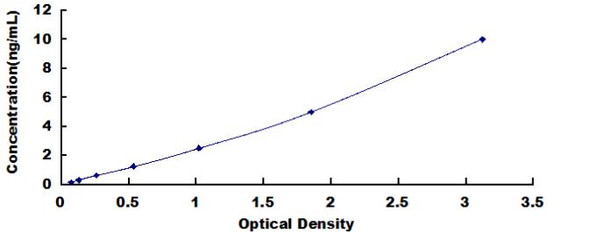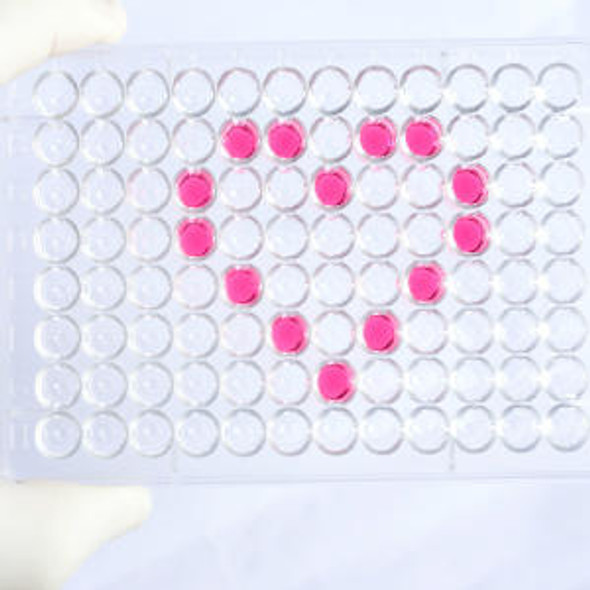Human Epigenetics and Nuclear Signaling ELISA Kits
Human MYC (V-Myc Myelocytomatosis Viral Oncogene Homolog) CLIA Kit (HUES00518)
- SKU:
- HUES00518
- Product Type:
- ELISA Kit
- ELISA Type:
- CLIA Kit
- Size:
- 96 Assays
- Sensitivity:
- 18.75pg/mL
- Range:
- 31.25-2000pg/mL
- ELISA Type:
- Sandwich
- Reactivity:
- Human
- Sample Type:
- Serum, plasma and other biological fluids
- Research Area:
- Epigenetics and Nuclear Signaling
Description
| Assay type: | Sandwich |
| Format: | 96T |
| Assay time: | 4.5h |
| Reactivity: | Human |
| Detection method: | Chemiluminescence |
| Detection range: | 31.25-2000 pg/mL |
| Sensitivity: | 18.75 pg/mL |
| Sample volume: | 100µL |
| Sample type: | Serum, plasma and other biological fluids |
| Repeatability: | CV < 15% |
| Specificity: | This kit recognizes Human MYC in samples. No significant cross-reactivity or interference between Human MYC and analogues was observed. |
This kit uses Sandwich-CLIA as the method. The micro CLIA plate provided in this kit has been pre-coated with an antibody specific to Human MYC. Standards or samples are added to the appropriate micro CLIA plate wells and combined with the specific antibody. Then a biotinylated detection antibody specific for Human MYC and Avidin-Horseradish Peroxidase (HRP) conjugate are added to each micro plate well successively and incubated. Free components are washed away. The substrate solution is added to each well. Only those wells that contain Human MYC, biotinylated detection antibody and Avidin-HRP conjugate will appear fluorescence. The Relative light unit (RLU) value is measured spectrophotometrically by the Chemiluminescence immunoassay analyzer. The RLU value is positively associated with the concentration of Human MYC. The concentration of Human MYC in the samples can be calculated by comparing the RLU of the samples to the standard curve.
| UniProt Protein Function: | Myc: a proto-oncogenic transcription factor that plays a role in cell proliferation, apoptosis and in the development of human tumors. Seems to activate the transcription of growth-related genes. |
| UniProt Protein Details: | Protein type:DNA-binding; Nucleolus; Oncoprotein; Transcription factor Chromosomal Location of Human Ortholog: 8q24. 21 Cellular Component: nucleoplasm; protein complex; nucleolus; nucleus; cytosol Molecular Function:protein dimerization activity; protein binding; DNA binding; protein complex binding; transcription factor binding; transcription factor activity Biological Process: oxygen transport; cellular iron ion homeostasis; positive regulation of transcription, DNA-dependent; positive regulation of caspase activity; negative regulation of transcription from RNA polymerase II promoter; Wnt receptor signaling pathway through beta-catenin; chromosome organization and biogenesis; positive regulation of fibroblast proliferation; transforming growth factor beta receptor signaling pathway; positive regulation of cell proliferation; positive regulation of mesenchymal cell proliferation; response to gamma radiation; cell cycle arrest; response to drug; transcription initiation from RNA polymerase II promoter; Notch signaling pathway; regulation of telomere maintenance; transcription, DNA-dependent; MAPKKK cascade; negative regulation of cell division; negative regulation of stress-activated MAPK cascade; negative regulation of monocyte differentiation; chromatin remodeling; ureteric bud branching; regulation of gene expression; negative regulation of fibroblast proliferation; energy reserve metabolic process; gene expression; positive regulation of transcription from RNA polymerase II promoter; response to DNA damage stimulus; positive regulation of epithelial cell proliferation; negative regulation of apoptosis Disease: Burkitt Lymphoma |
| NCBI Summary: | The protein encoded by this gene is a multifunctional, nuclear phosphoprotein that plays a role in cell cycle progression, apoptosis and cellular transformation. It functions as a transcription factor that regulates transcription of specific target genes. Mutations, overexpression, rearrangement and translocation of this gene have been associated with a variety of hematopoietic tumors, leukemias and lymphomas, including Burkitt lymphoma. There is evidence to show that alternative translation initiations from an upstream, in-frame non-AUG (CUG) and a downstream AUG start site result in the production of two isoforms with distinct N-termini. The synthesis of non-AUG initiated protein is suppressed in Burkitt's lymphomas, suggesting its importance in the normal function of this gene. [provided by RefSeq, Jul 2008] |
| UniProt Code: | P01106 |
| NCBI GenInfo Identifier: | 127619 |
| NCBI Gene ID: | 4609 |
| NCBI Accession: | P01106. 1 |
| UniProt Secondary Accession: | P01106,P01107, Q14026, A8WFE7, |
| UniProt Related Accession: | P01106 |
| Molecular Weight: | 439 |
| NCBI Full Name: | Myc proto-oncogene protein |
| NCBI Synonym Full Names: | v-myc avian myelocytomatosis viral oncogene homolog |
| NCBI Official Symbol: | MYC |
| NCBI Official Synonym Symbols: | MRTL; MYCC; c-Myc; bHLHe39 |
| NCBI Protein Information: | myc proto-oncogene protein; proto-oncogene c-Myc; transcription factor p64; class E basic helix-loop-helix protein 39; avian myelocytomatosis viral oncogene homolog; v-myc myelocytomatosis viral oncogene homolog; myc-related translation/localization regulatory factor |
| UniProt Protein Name: | Myc proto-oncogene protein |
| UniProt Synonym Protein Names: | Class E basic helix-loop-helix protein 39; bHLHe39; Proto-oncogene c-Myc; Transcription factor p64 |
| Protein Family: | Myc protein |
| UniProt Gene Name: | MYC |
| UniProt Entry Name: | MYC_HUMAN |
As the RLU values of the standard curve may vary according to the conditions of the actual assay performance (e. g. operator, pipetting technique, washing technique or temperature effects), the operator should establish a standard curve for each test. Typical standard curve and data is provided below for reference only.
| Concentration (pg/mL) | RLU | Average | Corrected |
| 2000 | 53006 58436 | 55721 | 55693 |
| 1000 | 22796 25152 | 23974 | 23946 |
| 500 | 11703 10361 | 11032 | 11004 |
| 250 | 5005 5583 | 5294 | 5266 |
| 125 | 2727 2489 | 2608 | 2580 |
| 62.5 | 1347 1275 | 1311 | 1283 |
| 31.25 | 627 721 | 674 | 646 |
| 0 | 28 28 | 28 | -- |
Precision
Intra-assay Precision (Precision within an assay): 3 samples with low, mid range and high level Human MYC were tested 20 times on one plate, respectively.
Inter-assay Precision (Precision between assays): 3 samples with low, mid range and high level Human MYC were tested on 3 different plates, 20 replicates in each plate.
| Intra-assay Precision | Inter-assay Precision | |||||
| Sample | 1 | 2 | 3 | 1 | 2 | 3 |
| n | 20 | 20 | 20 | 20 | 20 | 20 |
| Mean (pg/mL) | 101.79 | 276.13 | 918.81 | 104.29 | 252.58 | 950.51 |
| Standard deviation | 9.61 | 22.86 | 68.64 | 12.40 | 23.24 | 97.71 |
| C V (%) | 9.44 | 8.28 | 7.47 | 11.89 | 9.20 | 10.28 |
Recovery
The recovery of Human MYC spiked at three different levels in samples throughout the range of the assay was evaluated in various matrices.
| Sample Type | Range (%) | Average Recovery (%) |
| Serum (n=5) | 97-111 | 105 |
| EDTA plasma (n=5) | 89-103 | 94 |
| Cell culture media (n=5) | 91-106 | 98 |
Linearity
Samples were spiked with high concentrations of Human MYC and diluted with Reference Standard & Sample Diluent to produce samples with values within the range of the assay.
| Serum (n=5) | EDTA plasma (n=5) | Cell culture media (n=5) | ||
| 1:2 | Range (%) | 102-120 | 99-117 | 93-109 |
| Average (%) | 110 | 108 | 100 | |
| 1:4 | Range (%) | 87-102 | 102-116 | 95-107 |
| Average (%) | 94 | 109 | 101 | |
| 1:8 | Range (%) | 96-112 | 96-110 | 99-113 |
| Average (%) | 103 | 103 | 105 | |
| 1:16 | Range (%) | 89-99 | 88-102 | 85-96 |
| Average (%) | 94 | 96 | 90 |
An unopened kit can be stored at 4°C for 1 month. If the kit is not used within 1 month, store the items separately according to the following conditions once the kit is received.
| Item | Specifications | Storage |
| Micro CLIA Plate(Dismountable) | 8 wells ×12 strips | -20°C, 6 months |
| Reference Standard | 2 vials | |
| Concentrated Biotinylated Detection Ab (100×) | 1 vial, 120 µL | |
| Concentrated HRP Conjugate (100×) | 1 vial, 120 µL | -20°C(shading light), 6 months |
| Reference Standard & Sample Diluent | 1 vial, 20 mL | 4°C, 6 months |
| Biotinylated Detection Ab Diluent | 1 vial, 14 mL | |
| HRP Conjugate Diluent | 1 vial, 14 mL | |
| Concentrated Wash Buffer (25×) | 1 vial, 30 mL | |
| Substrate Reagent A | 1 vial, 5 mL | 4°C (shading light) |
| Substrate Reagent B | 1 vial, 5 mL | 4°C (shading light) |
| Plate Sealer | 5 pieces | |
| Product Description | 1 copy | |
| Certificate of Analysis | 1 copy |
- Set standard, test sample and control (zero) wells on the pre-coated plate and record theirpositions. It is recommended to measure each standard and sample in duplicate. Note: addall solutions to the bottom of the plate wells while avoiding contact with the well walls. Ensuresolutions do not foam when adding to the wells.
- Aliquot 100µl of standard solutions into the standard wells.
- Add 100µl of Sample / Standard dilution buffer into the control (zero) well.
- Add 100µl of properly diluted sample (serum, plasma, tissue homogenates and otherbiological fluids. ) into test sample wells.
- Cover the plate with the sealer provided in the kit and incubate for 90 min at 37°C.
- Aspirate the liquid from each well, do not wash. Immediately add 100µL of BiotinylatedDetection Ab working solution to each well. Cover the plate with a plate seal and gently mix. Incubate for 1 hour at 37°C.
- Aspirate or decant the solution from the plate and add 350µL of wash buffer to each welland incubate for 1-2 minutes at room temperature. Aspirate the solution from each well andclap the plate on absorbent filter paper to dry. Repeat this process 3 times. Note: a microplatewasher can be used in this step and other wash steps.
- Add 100µL of HRP Conjugate working solution to each well. Cover with a plate seal andincubate for 30 min at 37°C.
- Aspirate or decant the solution from each well. Repeat the wash process for five times asconducted in step 7.
- Add 100µL of Substrate mixture solution to each well. Cover with a new plate seal andincubate for no more than 5 min at 37°C. Protect the plate from light.
- Determine the RLU value of each well immediately.






